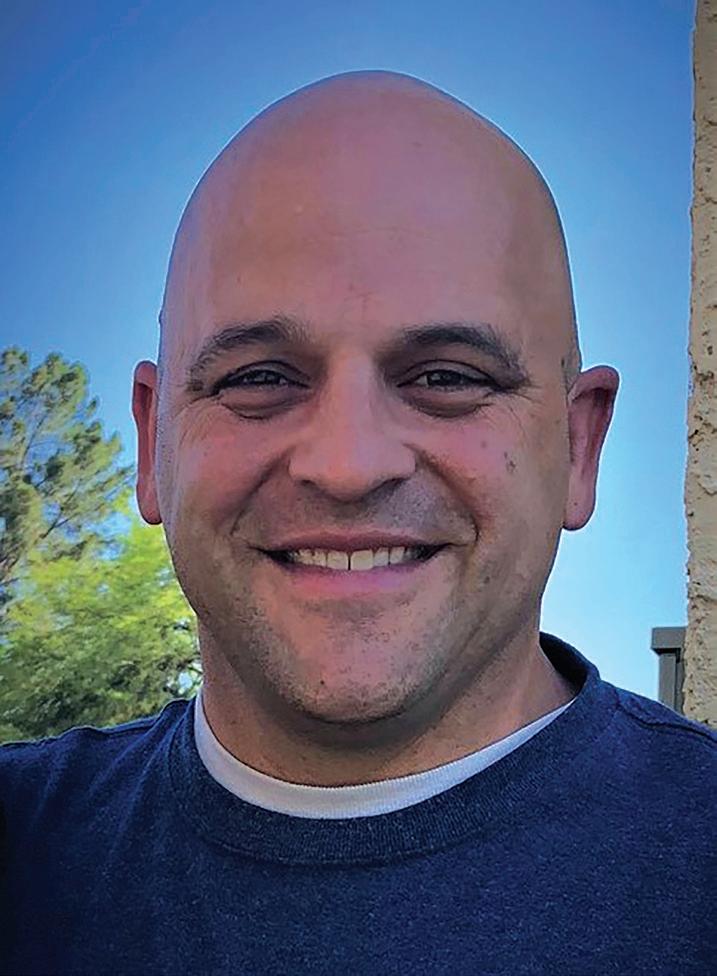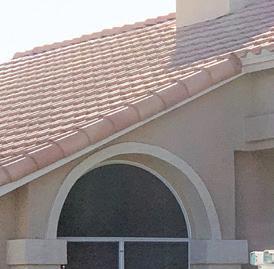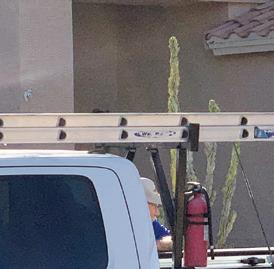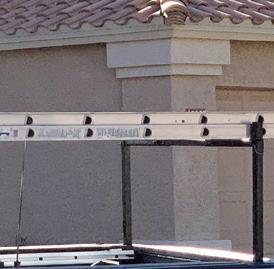
3 Gilbert teens honored

Six



3 Gilbert teens honored

Six

Aclimbing gym, more pickelball courts and an enclosed dog park are just some of the amenities that residents want to see in Gilbert.
The Parks and Recreation Department is soliciting public feedback as it develops a 10-year master plan for future services, programs and amenities as the town reaches build-out in less than a decade with a population of 330,000.
The department kicked off its communi-
in $1.7M

ty engagement campaign with the tagline “plan where you play” in April.
“It was important for us to really make sure that we really hit the community outreach component,” said Parks and Recreation Director Robert Carmona, who recently gave an update to the Planning Commission. “I think why we’re all here is to make sure that we can build the future that the Gilbert community wants within Parks and Recreation.”
He said the department wanted to reach 60,000 residents for their feedback.
“We wanted to make sure we reached
Aformer Future Farmers of America official is accused of opening a secret account with the organization’s money and misspending $1.7 million, including on his and his wife’s personal credit cards, while he worked in the state Education Department, the Arizona Auditor General said last week.
A state grand jury on May 31 indicted Tyler Grandil, 50, of Gilbert, on six felony counts related to computer tampering and fraudulent


out to the Gilbert Community and met them where they were,” Carmona said.
“We didn’t just want to hold workshops at some of the community centers. We wanted to go out to the parks, we wanted to go out to the HOAs, we wanted to attend their events – the Little League nights, the shops around Gilbert, the restaurants.
“So we have been tirelessly visiting everywhere in Gilbert all corners of Gilbert and really bringing that community engagement to everybody.”
Gilbert Police Department Peer Support and Wellness Officer McKay Lauritzen last week welcomed Finley, a 2-year-old Goldendoodle, to the force as the new therapy dog. He was donated by the Finley Fetch Foundation, which provides support, training and resources to first responders. (David Minton/Staff Photographer)





4.00% 12-Month CD

1
IN-BRANCH OR AT VANTAGEWEST.ORG/CD
1APY = Annual Percentage Yield. Membership required. Offer subject to change and restrictions may apply. Fees may reduce earnings. Early withdrawal penalties may apply. Certificates (CDs) earn dividends. Minimum opening deposit of $500. Will roll-over into a 12-month certificate at prevailing rate upon maturity. Rates valid as of 6/1/2023. Federally insured by NCUA.
CONTACT INFORMATION
Main number: 480-898-6500 | Advertising: 480-898-6559
Circulation service: 480-898-5641
Publisher: Steve T. Strickbine
Vice President: Michael Hiatt
ADVERTISING DEPARTMENT
Display Advertising: 480-898-6309
Classifieds/Inside Sales:
480-898-6500 | classifieds@timeslocalmedia.com
TJ Higgins | 480-898-5902 tjhiggins@timeslocalmedia.com
Steve Insalaco |480-898-5635 sinsalaco@timeslocalmedia.com
Advertising Sales Executive: Jane Meyer | 480-898-5633 jane@timeslocalmedia.com
NEWS DEPARTMENT
Executive Editor: Paul Maryniak | 480-898-5647 pmaryniak@timeslocalmedia.com
Managing Editor: Cecilia Chan | 480-898-5613 cchan@timeslocalmedia.com
Reporters:
Ken Sain | 928-420-5341 ksain@timeslocalmedia.com
Get Out Editor:
Christina Fuoco-Karasinski | 480-898-5631 christina@timeslocalmedia.com
Sports Editor: Zach Alvira | 480-898-5630 zalvira@timeslocalmedia.com
Photographer:
Dave Minton | dminton@timeslocalmedia.com
Design:
Nathalie Proulx | nproulx@timeslocalmedia.com
Design/Production Supervisor
Courtney Oldham | production@timeslocalmedia.com
Circulation
Aaron Kolodny | aaron@phoenix.org
Patti Serrano was engaged in one of the more enjoyable moments of being a member of the Chandler Unified School District Governing Board – handing out diplomas to 2023 graduates.
She said it seemed like every Latina student who approached her for their diploma sheepishly had a request.
“Can I hug you?”
“I knew what that meant,” Serrano said. “I’m not a fan of identity politics, per se. If I walk into an elementary school, eyes open up. I was that kid, even into my adulthood. I am that person in some spaces today. It is true, representation matters.”
Serrano, the first Latina elected to the board, is wrapping up her first six months on the job and said that in many ways, it is better than she expected.
“I didn’t think that we would be as effective as we have proven to be so early on,” Serrano said.
She pointed to one major achievement in her first few months on the job: The district is considering what to do with nine schools that are struggling to attract students.
Soon after she took the oath for her new office, she found out the district was considering closing San Marcos Elementary School and sending those students somewhere else.
San Marcos is just south of downtown and has a high Latino enrollment. There was outrage in the community and a movement started to save San Marcos.
But it didn’t last long because the district soon changed course and decided to keep San Marcos open.

Serrano said she had a lot of conversations with district officials at the time before they changed their mind.
“I was not prepared to jump into that within my first month of serving on the board,” Serrano said. “But we did. … I was able to connect with those directly impacted, and I really do feel like my voice helped influence the outcome.”
Serrano grew up in Tucson and moved

to Chandler to attend Hamilton High School because her sister started teaching there.
She is not related to the Serrano family best known for their Mexican food restaurant, a question she got often during the campaign. She said most people know they are not related and she rarely gets that question anymore.
She graduated from Arizona State University with a bachelor of science degree in microbiology. She now works at ASU as an academic researcher, focusing specifically on children’s health.
She has one son who will start attending Hamilton in the fall.
Her career as a researcher has led her to trust the data. It’s something she says she brings to her role on the Governing Board.
“I really do come at things from more of a data-oriented angle,” Serrano said. “I do come from more of a science background, but also because of my workplace, understanding the implications of what statistics tell us and how we really make improvements. I think they it’s a really solid marriage for the work that we do as a district.”
Serrano said her priority going forward is just what she campaigned on – being a top advocate for district employees, especially teachers.
“We need, just like any employer, to treat our workers with dignity and make sure that we’re looking out for the best for our teachers,” she said. “And we all know that we’re facing a retention challenge.
“So, looking out for our teachers, I think, has been a pivotal role in my first six months.”
While there are the fun parts of the job, such as handing out diplomas, a lot of the work a Governing Board member does is not seen. It’s staying up late on a Monday night to read the agenda and all of the supporting documents. It’s returning hundreds of emails from parents, students and teachers.
And every now and then a request for a hug from a young woman.
“I kind of get that reminder, not necessarily that I’m the first, because that shouldn’t matter,” Serrano said. “Just the fact that we have representation, real time in someone’s life, it really is meaningful. And it puts me back to that place of I know what that feels like.”








































































































































































Voters across the state are likely to get to decide whether Maricopa County residents get a chance to extend the half-cent sales tax for transit projects.
Gov. Katie Hobbs said last week she will back a proposal to put an issue on the 2024 ballot repealing a state law that requires only Maricopa County to get legislative approval before putting the tax renewal to voters.
That move was supported in a letter signed by six Valley mayors – including Gilbert’s Brigette Peterson, Chandler’s Kevin Hartke and Mesa’s John Giles.
The letter ripped “a very small group of lawmakers – all Republicans linked to the so-called “Freedom Caucus” – for derailing the ballot measure, accusing the “uncompromising band of lawmak-
ers” of “spouting the half-truths of fringe special interests.”
The governor acknowledged that she could call lawmakers back to the Capitol after she vetoes the funding plan approved June 13 by Republican lawmakers.
Hobbs said what was sent to her is unacceptable, from less money for mass transit than sought by the Maricopa Association of Governments to the fact that the GOP plan would require two separate votes.
“I don’t think it serves anyone’s purpose if they’re not willing to come to the table and talk about a deal,’’ she said. “And that requires some cooling off.’’
Time, however, is not a likely answer.
“This is going to be the only bill that passes this session’’ on extension of the tax,’’ said Rep. David Livingston, R-Peoria of the GOP plan.
Other Republicans made it clear that if

Hobbs won’t accept their plan, Maricopa County voters will have no chance to extend the levy, first approved in 1985, for another 20 years.
If that’s the case, they claimed, the current tax will self-destruct at the end of 2025. And all the funds it would raise – an estimated $20 billion over the next two decades – would not be collected and all the projects that the cash would fund will not happen.
But Avondale Mayor Kenn Weise, chairman of MAG, said that’s not true. He sent a letter to the governor seeking a veto.
That leaves what Weise called the “Free Maricopa’’ initiative. He said the idea is to sell voters statewide on the idea that residents of the state’s largest county should not be hobbled by a restriction that doesn’t apply anywhere else.
“Maricopa County is the only county in the state that has to go through this
process’’ of getting the blessing of state lawmakers to ask voters to extend the tax, Weise said. “And we’ve seen just how disastrous that can be.’’
What that would mean is getting 255,949 valid signatures on petitions by July 3, 2024 to put the issue to voters that November. Then, if it passed, it would be up to the Maricopa County Board of Supervisors to set a date for a special election in early 2025 on extending the tax to kick in when the current levy expires at the end of that year.
Livingston said he doubts the business community would pony up multiple millions of dollars to get the signatures for the initiative and then probably $10 million or more to persuade voters statewide to let Maricopa County out from under the legislative restriction. Weise said he doesn’t foresee a prob-


















lem getting the necessary backing, especially in the wake of Republicans telling Maricopa County, effectively, that when it comes to a transit tax, it’s their way or the highway.
Hobbs said she believes that voters statewide would be willing to support repeal of the restrictions under which Maricopa County has to operate.
“They’re holding them hostage,’’ she said. “It is ridiculous that Maricopa County has to go to the Legislature to get permission to go to the ballot for something for their region.’’
Moreover, she said, “If Maricopa doesn’t get this, then every other region of this state is going to be competing with Maricopa for transportation dollars.”
All that goes to the question of why the Legislature decided that it needed to have veto power over the Maricopa plan.
“They thought that a government agency like MAG could have too much
power,’’ Livingston said.
Livingston sidestepped the point that MAG lacks the power to impose a levy.
Ed Zuerker, MAG’s managing director, told Capitol Meda Services: “We have given on freeways. They wanted more freeways, so we increased the freeway number.’’
At the same time, Zuerker said, MAG decreased the percentage it was seeking for transit. And he said the organization even agreed that any light rail extensions would be funded by other revenues.
Zuerker said MAG even agreed to language to require Valley Metro to meet certain “benchmarks,’’ based on comparable cities, of what percentage of the operating costs of buses, trolleys and light rail would be covered by fares.
“We just have hit a limit of there’s no more to give,’’ he added,
Hobbs and MAG want an extension of the half-cent levy for 20 years, with 40% of the proceeds going towards freeways, an identical amount to mass transit, with the balance for regional and arterial roads.

By contrast, Republican lawmakers authorized a vote on a 0.0495 cent levy, with a larger share going towards freeways. They also want voters to separately approve a 0.07-cent tax for construction and extension of light rail.
House Speaker Ben Toma said what Republicans approved gives Hobbs and MAG, made up of local elected officials, what they want: the chance to extend the sales tax until 2045.
Republican Rep. Barbara Parker said during debate the experience in her home community of Mesa, where the light rail now runs, suggests to her that residents have seen enough.
“The light rail not only destroyed our historic Main Street and downtown Mesa, but it destroyed lifelong businesses of families and generations of business that had been there for years and year,’’ she said.
“We are funding a loser,’’ Parker said. “In our town, it’s a moving urinal and that is it.’’
But Democrat Lorena Austin, also representing Mesa, painted a different pic-
ture. “If you’ve been to downtown Mesa, even in just the past year, you would see that all the retails are actually booming,’’ Austin said. “We can’t get businesses in there fast enough. And it has everything to do with public transportation.’’
Senate Minority Leader Mitzi Epstein, D-Tempe, told colleagues that short-changing mass transit is not a good move, stating:
“If we continue to have the idea that everything must be a single driver in a car on a road, we will just get to the point of having to pave every speck.’’
Senate President Warren Petersen, R-Gilbert, said the GOP plan does not mean that there will never be a further extension of light rail. What it does mean, he said, is that it won’t be paid for by everyone who buys items subject to sales taxes throughout Maricopa County.
“If cities want to do light rail, you know what?’’ Petersen said. “They can find ways to fund it and do it.’’
Bob Christie of Capitol Media Services contributed to this story.

FFA from page 1
schemes that allegedly occurred during his last four years on his job , according to court documents. His trial is scheduled for Nov. 22.
Grandil, who became the FFA executive secretary in June 2000, declined to comment.
FFA is a nonprofit that prepares youth for agricultural careers and is one of six student organizations in the state department’s Career and Technical Education program. Chapters exist at various schools throughout the East Valley.
Grandil’s lawyer, Evan Tomkins, said in an email, “There is a lot we would like to say about Tyler Grandil, his integrity, and his devotion to Arizona Students. But we respect and want the legal process to run its course.
“For 15 years, Mr. Grandil selflessly served the students of Arizona through his leadership with the Arizona Chapter of the Future Farmers of America. His efforts led the FFA to reach new heights - more than doubling its membership, while orches-
trating innovative funding mechanisms that continue to provide financial stability through this day. His devotion to Arizona agricultural education brought incredible learning experiences and opportunities to thousands of students.
“We have not spoken with or been informed of an Arizona FFA member or student who is anything but grateful for Mr. Grandil’s selfless work. Regarding a ‘secret’ bank account, this account was an FFA bank account created with the FFA tax-identification number and the proceeds therein were used for FFA non-profit purposes.”
Tomkin added, “Mr. Grandil emphatically denies any wrongdoing.”
The Auditor General looked at financial transactions from March 2011 through December 2015, when Grandil was fired from the organization.
Investigators stated that in March 2011, without the knowledge of the FFA or the Education Department, Grandil opened a checking account under the name “Arizona Association FFA,” and deposited $1.7 million in of the Future Farmers’ mon-


ey, which included student and chapter membership dues and conference registrations.
He designated himself as the sole signer.
The money instead should have been
deposited in the education department’s AZFFA checking account, according to the Auditor General.
Grandil’s duties at the time involved leading the program’s day-to-day operations and managing its finances.
“To help conceal his actions, Mr. Grandil altered 483 invoices in the department’s accounting software, making it falsely appear AZFFA monies were not due to be deposited in the department checking account, and he instead deposited those monies in his secret ‘Arizona Association FFA’ checking account,” the report said.
It added that Grandil’s actions resulted in the monthly financial reports omitting these revenues and associated expenses.
The report also stated that Grandil failed to obtain his supervisors’ approval for any of the $1.7 million in expenditures.
“Mr. Grandi admitted that he used five personal credit cards for both AZFFA and personal purposes, commingled AZFFA and personal monies for payments, and failed to keep a separate accounting that



tracked AZFFA and personal purchase,” according to the Auditor General.
“As a result, we were unable to determine how much of the ($1.6 million) Mr. Grandil spent from March 2011 to December 2015 toward paying the balances on his personal credit cards was for either AZFFA or personal purposes.”
and his wife used their personal monies to make a $10,000 payment on one of their personal credit cards,” the report said.
“Nonetheless, it is still unclear if this payment was for a loan to AZFFA because... their credit card balances included both AZFFA and personal charges.”
department separated responsibilities for receiving, depositing and recording AZFFA monies or routinely generated audit-trail reports from the accounting software.
According to the report, department employees now serve in an advisory and assistant capacity to AZFFA and not in a management or decision-making role.
Grandil also is alleged to have used $41,000 from the secret account to pay his family members and himself. From May 2011 to August 2015, Grandil allegedly issued 18 checks totaling $29,500 from the account to his family members, their companies or their companies’ credit card, the report stated.
Although the family members claimed that Grandil hired them to provide goods and services to AZFFA, they were unable to provide documentation to prove that, investigators said.
Also, from February 2012 to October 2015, Grandil wrote to himself 10 checks totaling $11,450. He claimed they were for reimbursements for a $10,000 loan he provided to AZFFA in 2010 to cover amounts he charged to his personal credit cards.
“Although Mr. Grandil did not provide documentation to support this loan, we found that in January 2011, Mr. Grandil


The report said that Grandil spent the remaining $68,240 for AZFFA and other purposes. From March 2011 to December 2015, he used $27,355 to pay for AZFFA disbursements such as conference and hotel expenses, $12,626 for bank charges and $1,081 for “likely personal purposes such as payments to a home warranty company and a telecommunication company.”
Managing the AZFFA, including the finances, shifted to its advisory board in 2017.
Grandil had a long history with FFA. He began working as a part-time FFA consultant in July 1997 until he transitioned to the executive secretary role.
But prior to that, at the age of 20, he was elected vice president the FFA’s Western
Region in November 1993, according to the Deseret News, owned by the Church of Jesus Christ of Latter-day Saints.
According to Grandil’s Linkedin account, he, his brother and his father own a beef operation.
After the FFA, Grandil in 2016 assumed the executive director’s role with Arizona National Livestock Show, where he remained in as of last week.
The show is the largest livestock show in the Southwest – bringing nearly 1,700 head of the nation’s best cattle, horses, sheep, goats, swine and poultry for competition - and an annual Phoenix tradition since 1948, according to the organization. FFA from page 8
The investigators faulted former education department officials for allowing Grandil to be the direct recipient of all AZFFA revenues, make deposits in the department’s AZFFA checking account, record those deposits in the department’s software and be the administrator of that software, which allowed him “unfettered access and control of AZFFA monies.”
During the time period of Grandil’s alleged misdeeds, he served under Republican state Superintendents of Schools John Huppenthal and Diane Douglas.
The report said the misuse of public monies could have been avoided had the





Mesa, AZ - When it comes to chronic pain and/ or neuropathy, the most common doctor-prescribed treatment is drugs like Gabapentin, Lyrica, Cymbalta, and Neurontin. The problem with anti-depressants or anti-seizure medications like these is that they offer purely symptomatic relief, as opposed to targeting and treating the root of the problem. Worse, these drugs often trigger an onset of uncomfortable, painful, and sometimes harmful side effects.
The only way to effectively treat chronic pain and/or peripheral neuropathy is by targeting the source, which is the result of nerve damage owing to inadequate blood flow to the nerves in the hands and feet. This often causes weakness and numbness.

As displayed in figure 1 above, the nerves are surrounded by diseased, withered blood vessels. A lack of sufficient nutrients means the nerves cannot survive, and thus, slowly die. This leads to those painful and frustrating consequences we were talking about earlier, like weakness, numbness, tingling, balance issues, and perhaps even a burning sensation.
The drugs your doctor might prescribe will temporarily conceal the problems, putting a “BandAid” over a situation that will only continue to deteriorate without further action.
Thankfully, Mesa is the birthplace of a brand new facility that sheds light on this pressing problem of peripheral neuropathy and chronic pain. The company is trailblazing the medical industry by replacing outdated drugs and symptomatic reprieves with an advanced machine that targets the root of the problem at hand.

Effective neuropathy treatment relies on the following three factors:
1. Finding the underlying cause
2. Determining the extent of the nerve damage
(above 95% nerve loss is rarely treatable)
3. The amount of treatment required for the patient’s unique condition
Aspen Medical in Mesa, AZ uses a state-ofthe-art electric cell signaling systems worth $100,000.00. This ground-breaking treatment is engineered to achieve the following, accompanied by advanced diagnostics and a basic skin biopsy to accurately analyze results:
1. Increases blood flow
2. Stimulates and strengthens small fiber nerves
3. Improves brain-based pain
The treatment works by delivering energy to the affected area(s) at varying wavelengths, from low- to middle-frequency signals, while also using Amplitude Modulated (AM) and Frequency Modulated (FM) signaling.
It’s completely painless!
THE GREAT NEWS IS THAT THIS TREATMENT IS COVERED BY MEDICARE, MEDICAID, AND MOST INSURANCES!!
Depending on your coverage, your peripheral neuropathy treatment could cost almost nothing – or be absolutely free.
The number of treatments required varies from patient to patient, and can only be determined following an in-depth neurological and vascular examination. As long as you have less them 95% nerve damage, there is hope!
Aspen Medical begins by analyzing the extent of the nerve damage – a complimentary service for your friends and family. Each exam comprises a detailed sensory evaluation, extensive peripheral vascular testing, and comprehensive analysis of neuropathy findings.
Aspen Medical will be offering this free chronic pain and neuropathy severity evaluation will be available until June 30th, 2023. Call (480) 2743157 to make an appointment.
Due to our very busy office schedule, we are limiting this offer to the first 10 callers. YOU DO NOT HAVE TO SUFFER ANOTHER MINUTE, CALL (480) 274-3157...NOW!!
We are extremely busy, so we are unavailable, please leave a voice message and we will get back to you as soon as possible.
Gilbert is partnering with Mesa to explore the feasibility of owning and operating a waste management system to efficiently collect and sort trash, saving taxpayers money.
Town Council without comment on June 6 approved sharing in half of the cost or $230,000 for the initial design of a waste transfer station and a material recovery facility or MRF. Mesa is the lead agency on the project.
“This preliminary design is intended to help us determine what the overall costs would be for the project and detail what an operating agreement with Mesa might look like,” town spokeswoman Jennifer Snyder said. “We will then decide if we want to move forward with the full design and construction.”
Transfer stations move waste efficiently from the point of collection in neighborhoods to distant, regional landfills or recycling facilities outside of town limits, according to a report by Paul Montes, solid waste and recycling manager.
An MRF processes, sorts and bales collected recyclable material such as aluminum, plastics, cardboards and paper, he added.
Montes said given the rising costs of processing recyclables, combined with the shrinking list of what is in demand, have caused instability within the recycle market.
Exploring a regional facility and its impact in the community is necessary for the future of the town’s recycling program, he said.
Gilbert currently pays third-party vendors for both its transfer station and recycling services.
Weekly pick-ups of recyclables have become a money-loser for Gilbert.
After China in 2017 began restricting the import of most of the world’s recyclables, Gilbert and other municipalities in the country have seen their recycling programs go from being a revenue generator to where it was costing them.
Gilbert was earning money from its recyclables up until Fiscal Year 2019, when it saw a profit of $343,000, according to the Town. From fiscal years 2020 to 2023, the cost per ton for processing recycle material outpaced the cost to send waste to the landfill.
Environmental Services in 2022 collected just over 18,000 tons of recyclables, diverting 17% of waste from ending up in the landfill, according to Snyder.
She said the preliminary design is expected to begin this summer.
“Gilbert and Mesa are reviewing the current and long-term needs of our programs to best determine size and capacity of the facility,” she added.
And though both municipalities are sharing in that cost equally, the Town’s portion of the construction cost is yet to be determined, Snyder said.
Gilbert has been dealing with this challenge for years and in January, council approved a $50,000 contract with Arizona State University’s Project Cities Program, for students to come up with creative ideas.
The scope of work included having the students look at the feasibility of an in-house sorting facility versus the town continuing to contract with a vendor and exploring new and devising innovative ways to divert waste from landfills while creating a market for them.
The students also were tasked with exploring how the Town can manage Environmental Services’ fleet and see WASTE
Efforts in the state Capitol to address the rising cost of housing have imploded, at least in part because conservative Republicans are unwilling to override local regulations, even with the consent of affected communities.
Sen. Steve Kaiser acknowledged that the comprehensive zoning overhaul won’t happen this year despite the deal he struck with the League of Arizona Cities and Towns on a slimmed-down version of his original proposal.
The Phoenix Republican also had picked up support from many Democrats who see local zoning and “NIMBY-ism” as ways communities keep out “affordable’’ housing.
The deal would have set state standards for zoning, requiring cities and towns to allow backyard casitas and a mix of new smaller developments including small lots sizes, duplex and tri-plex homes and manufactured housing. But it ended up going a bit too far for many.
Rep. Neal Carter, R-San Tan Valley, said Kaiser’s baseline restrictions on local zoning powers were fraught with problems.
“I do not want to turn the Legislature into the local zoning board,’’ he said. And that, said Carter, is exactly what would happen if questions of size and density suddenly became matters that were governed by state law.
Rep. Alexander Kolodin, R-Scottsdale, said his opposition to Kaiser’s plan was even more basic.
“He just never got my voters to a place of comfort with this,’’ he said of the idea of stripping certain planning and zoning decisions away from local boards and councils.
And in a Twitter post, Mesa Republican Rep. Jacqueline Parker,
described the package as “horrible, suburb-destroying bills.’’
Kaiser wanted to jump-start the construction of smaller, cheaper housing in already built-up municipalities to ease a housing crunch that has made it impossible many people to find rental homes they can afford. One result is rising homelessness.
But he could not even get a majority of fellow Republicans in the House to get on board.
And the Senate, in a separate action, overwhelmingly rejected a backstop measure on June 12 that was designed in a way to garner support from the conservative “Freedom Caucus.’’ It did not work.
“Ultimately, I think members just want to slow down and really work on a better product during the interim and then run something in January,’’ Kaiser said. “I think a lot of them were a little bit uncomfortable with just how fast everything was moving and how complex the issues are.’’
House Majority Whip Teresa Martinez agreed.
“This was too much to absorb,’’ said the Casa Grande Republican.
Sen. Anna Hernandez, D-Phoenix, who was at the forefront of Democrats working to expand access to affordable housing, expressed frustration.
“When we earn constituents’ votes, those come with accountability,’’ she said. “So constituents need to ask their legislators why they are voting ‘no’ on affordable housing measures and measures that will ultimately bring affordable housing in the middle of a crisis.’’
The Home Builders Association of Central Arizona has been a key backer of Kaiser’s original package.
But lobbyist Spencer Kamps said the key element of the original package was the effort to cut down on
see BILL page 12







BILL from page 11 WASTE from page 10
what he said is the red tape in getting a new development approved.
“The private sector can’t respond to the market quick enough when demand increases,’’ he said, with the problem being local regulations. The result, said Kamps, is an “artificial spike in pricing because of the supply.’’
And delay, he said, is a big part of it.
But he was buoyed by emerging and “long overdue” efforts in cities, including Phoenix, to voluntarily change their zoning regulations to allow developments that is more affordable than the single-family homes that have been a hallmark of development in Arizona for decades.
“If the local governments can match supply with demand, then there’s no need for the state to be involved,’’ he said.
equipment more efficiently.
The final project summary report is due to the Town by Dec. 31.
Mesa City Council on Monday is also expected to approve the same agreement.
The third-largest city in the state doesn’t own these facilities and like Gilbert relies on private vendors, which it says exposes its recycling program to significant market risks.

“My industry literally 40 years ago you could be able to get a subdivision approved from raw land to the first home sale in about two years,’’ Kamps said. “And we’re not up to about four years.’’
Kamps said that by the time Kaiser was done amending it after negotiations with the League of Arizona Cities and Towns and others, his organization decided to neither support or oppose it
Kaiser seemed resigned and even supportive of calling a pause to his efforts.


Still, he said that even if a large number of municipalities adopt new zoning rules that match what he believes is needed, they should not expect him to just drop his efforts to force zoning changes.
“I think there’s still so much work to be done on zoning,’’ Kaiser said.
“It’s so complex,’’ he said. “There’s a million layers and barriers you can reduce, to speed up the process, but still respect local input. So there’s still work to be done for sure. But they’re moving in the right direction.’’
Mesa conducted a feasibility study in 2022, which recommended that it move forward with designing its own MRF/transfer station but to find partners as going at it alone would be a costly venture. The study also recommended putting the facilities at Pecos and Sossaman roads.
If both municipalities opt to move forward with construction, Mesa City Manager Chris Brady told his council that it would take three to five years to build.





The judge overseeing Legacy Park’s Chapter 11 bankruptcy case on June 15 approved $9 million in so-called debtor-in-possession financing to keep the 320acre sports park operating while it seeks a buyer.
Despite objections to the plan by the U.S. Attorney’s Office, Judge Daniel Collins said in his order that allowing the park to continue operating would “preserve the value of its estate.”
That is important for maximizing what can be recovered by investors and contractors still owed money by park owner Legacy Cares.
Legacy Cares owes over $300 million to bondholders who financed the park and over $30 million to contractors and other creditors.
The park has burned through its cash reserves and needs infusions to keep the lights on.
Budget documents filed in court show that Legacy Park has a gap between revenue and expenses of about $1 million per month.
For June, the park projects about $1.6 million in revenue against $2.8 million in expenses.
Collins’ approval of emergency funding came after major objections to the plan were filed with the U.S. Trustee Program, an arm of the U.S. Justice Department tasked with what a government website called the monitoring “of bankruptcy cases and detecting fraud.”
The attorney’s filing said that because of “potential misfeasance and malfeasance leading up to the debtor’s failure,” greater transparency is needed around the park’s operating budget and leadership structure before more cash is handed over.
Several contractors still owed money by Legacy supported the U.S.
Trustee’s concerns.
The filing is significant because it’s one of the first times a regulator has raised in writing suspicions of financial wrongdoing in Legacy Park’s operations.
In April, North Dakota Securities Commissioner Karen Tyler ordered Michael Kuntz to cease selling unregistered securities related to the park. He is the architect of Legacy Park and president of National Sports Opportunity Partners, which invested in the park’s amenities.
Tyler further ordered Kuntz to repay investors and pay a hefty fine.
The commissioner accused Kuntz of accepting and receiving payments from investors “in a Ponzi-like manner” and documented $12 million in payments from Kuntz to Legacy Sports executives Chad Miller, Randy Miller and Michael Baggett.
In April, Legacy Cares announced that it was terminating its management agreement with Legacy Sports and bringing on a new park manager, Elite Sports Group.
The U.S. Trustee pointed out that Elite Sports Group is a Delaware entity formed a few months before it signed the management agreement with Legacy Cares.
“The actual members and managers of Elite are not easily discoverable through public records,” the U.S. Trustee wrote.
The trustee also noted that the management agreement was signed by Brett Miller, an executive of Legacy Sports and the son of Legacy founder Randy Miller.
“There may be issues regarding the misappropriation of bond funds or claims of fraud or negligence with respect to pre-(bankruptcy) conduct by the principals of Legacy Sports,” the filing states.
“It is crucial that any involvement


by the owners of Legacy Sports via affiliation with Elite be disclosed and that Elite’s owners, managers, and control persons be specifically identified in this case.”
Moreover, Elite was not registered with the Arizona Corporation Commission to do business in the state at the time of the filing, something Legacy says it is insisting Elite correct immediately.
The attorney also criticized “excessive management and professional fees” in Legacy Cares’ budget.
“Doug Moss as president is being paid $245,000 per year, and Rodney Reese as general manager is being paid $200,000 per year,” the filing
OBJECTIONS from page 13 Check
states.
“In light of Mr. Moss’s history with Legacy Sports, the continued employment of Moss as president of the debtor during this bankruptcy is troubling to say the least,” it continues.
“Debtor has not specifically articulated precisely what function Moss will serve beyond being the ‘face of the company’ for purposes of a proposed sale. For that limited function, the payment to Mr. Moss of a $245,000 yearly salary is patently unreasonable.”
Moss previously served as president of the Arizona Coyotes before leaving the organization in 2010.
Legacy filed a response last week in which it said claims of excessive
fees are “off base.” Legacy also denied that bond proceeds were misappropriated under Moss’s watch.
“There is no proof whatsoever that ‘hundreds of millions of dollars’ was taken. Indeed, if that had happened, the Park would never have been built,” the filing states, adding that construction was primarily overseen by park manager Legacy Sports.
Legacy said the family relationship between Brett Miller and his father and brother was “concerning,” but it has “put in place controls to ensure that Randy and Chad Miller have no involvement in the park.”
“If Randy or Chad Miller were involved in any meaningful way in Park operations, debtor would know about it,” the filing continues.
Regarding the lack of information on the managers and officers of Elite, Legacy Cares said it has requested Elite provide this information, but does not have the power to compel the disclosure.
To support its claims that there is

now distance between the former heads of Legacy Sports and the current park operators, the filing says, “Mr. Moss’ relationship with Legacy Sports’ principal, Randy Miller, became strained in 2021,” and “in the late winter/spring of 2022, Randy Miller twice sought to have Mr. Moss fired from his position with debtor.”
Legacy also submitted a more detailed operating budget to the court and corrected technical errors identified by the Trustee.
After considering the objections and testimony from Legacy Cares, the bankruptcy judge allowed the park to move forward with emergency financing.
“Having an assured cash flow will encourage employees, customers and vendors to deal with debtor on an ongoing basis,” the judge wrote.
This would prevent Legacy Park from having to “close the park and liquidate assets to the substantial detriment of the estate and all stakeholders.”
It’s hard to prepare for the words, “You have cancer.” And when you hear them, it feels like a million questions are racing through your mind. What’s next? Who do I call? Where do I go? We have answers for you. We’ve been training for this moment, so we can be there the second you need us. Let’s take on this diagnosis together.
We’re ready for cancer. Cancer isn’t ready for us.


















He cited an event for kids 5-12, letting them design and build their own playground with the goal of taking “that knowledge and use it when it’s time to design some of the newer playgrounds.”
Residents also were mailed surveys and were able to give input on the department’s online idea wall with an interactive map, sharing what they wanted and where they wanted it.
“To this date we are over 11,000 website visits,” Carmona told the commissioners. “It’s actually pretty fascinating to go in there and see some of the feedback so far with a lot of great ideas from the community.”
According to the online input, the most sought-after amenity is pickelball courts – both indoor and outdoor.
Other asks include a botanical garden, a pollinator garden for butterflies and bees, bike park with pump tracks, splash pads, adult tennis clinics and a big shaded water park at Freestone Park.
Some atypical requests include a ceramic studio, “graffiti friends art areas,” where people can bring their own paint and express themselves in a safe environment and graduated areas or


“Design Your Own Playground” workshop June 10 at Southeast Regional Library in Gilbert.
inexpensive duck ramps to prevent “baby ducks drowning in park lakes.”
There’s also a request for a monthly or bi-weekly parents night out event where they can drop off their kids at a rec center for a couple of hours at a reasonable price while they go out on a date.
Through all those outreach efforts, “we’re going to be real close to hitting that 60,000,” Carmona said.
Carmona said the outreach is anticipated to conclude in mid-July.
PARKS from page 16
“It’s going to take us quite a bit of time to kind of put all that information together, all the data that’s being collected,” Carmona said, adding that the department also will look at what amenities are being offered in the private sector.
The next steps include the consultants evaluating levels of service, benchmark Parks and Recreation resources and assessing the recreation programs, including budget, staffing, needs and operations.
Carmona said the aim is to have a draft plan completed by December and presented to the town council.
Commissioner Anthony Bianchi asked how the master plan will balance the growth occurring in the south against the aging facilities in the town’s northern and western areas so that the amenities are “kind of spread equally.”
“That’s going to be one of the challenges we face,” Carmona responded. “We need to make sure that we’re pro-
viding those services to everyone in Gilbert.”
Carmona said that in the feedback, residents also are asking for more amenities in the south, adding, “there’s been quite a balance of people who are not only asking for those southern Gilbert amenities but also saying, ‘hey we have our parks like Freestone, McQueen some of those that are now approaching that 20, 30year period.’”
“We’ve been able to replace things like the playgrounds but it may not have some of the newer amenities that you’d see at a newer park like Gilbert Regional or Desert Sky,” he added.
“So one of the ways that we’re going to look at that is taking a look at what the most requested amenities are overall from the community, taking a look at that community feedback in terms of by location and figuring out how we can best put a plan together to present to the advisory board, to town council and to the community on how we can appropriately place things in
an equitable manner that kind of gives the best access to all.”
Commissioner Lisa Gage wanted an update on pickelball courts at the 273acre regional park.
“On behalf of my 10-year-old, I would like to know when are there going to be more pickleballs at Gilbert Regional Park because she’s dying to learn how to play,” she said. “But every time we drive by it is packed of people.”
Carmona said it is one of the most requested amenities for the regional park, which currently has 16 pickleball courts. The Town debut the first of three phases for the park in 2019.
Carmona said the next round of community outreach on amenities at the regional park will be in the fall.
“We’re going to go into full design of the remaining section of Gilbert Regional (next year) and that will really be our time where we’ll be able to design where that could be,” he said. “There are close to 400 acres of undeveloped land as well in the park system that we can be creative with.”
Carmona added that what they are seeing with some of the existing amenities are their close proximity to each other.
For instance, the town’s dog parks at Cosmo and Crossroads parks, are very close to each other, he said.
There’s lot of interest in having a dog park at Gilbert Regional and other areas of town, he said.
“So, how do we best take what we have and maybe look for more creative usage of our space to kind of grow that,” Carmona said. “It doesn’t always have to mean we have to do a lot of development. It may just mean there’s smaller wins sometimes down the line of just how we can reutilize some of the space we already have.”
Pitch in
For more information and to provide input on Gilbert Parks and Recreation’s master plan, go to berrydunn. mysocialpinpoint.com/town-of-gilbert-parks-rec-masterplan

Chandler Unified Superintendent Frank Narducci said it has taken a while, but the school district finally has a plan in place to help students struggling with mental health issues.
“We’ve been working with, and struggling with, this for the last four years, since the pandemic,” Narducci said during the June 14 Governing Board meeting. “I’m very proud of our district for moving forward this way.”
At the June 14 meeting, the Governing Board approved agreements with The Hope Institute and Lighthouse Wellhealth Clinic to provide mental health services to students.
CUSD officials have faced criticism from students and the community over not doing enough for stu -
dents’ mental health since May 2022, when three of its students died by suicide in 10 days.
The district plans to roll out its new mental health plan this fall. Here is how it will work:
If a student is struggling with mental health issues, they will be referred, when appropriate, to The Hope Institute as a first step. The goal would be that any student who needs help could get an appointment by the next business day.
The Hope Institute is based in Ohio but wants to branch out nationally. As part of that effort, clinic leaders must show their approach works in different parts of the country. This fall they will start clinics in Georgia and Arizona.
The Arizona clinic will be based in a discrete building at Perry High School. The goal of The Hope Institute is short-term care, getting stu -

dents past whatever crisis they are dealing with. As such, it can care for students for only about four to six weeks.
Still, some students may need longer-term care. Once the shortterm concerns are addressed, The Hope Institute can recommend longer-term care facilities to the parents.
The district has partnered with Lighthouse Wellhealth and Southwest Behavioral Services for longer-term care, but parents could choose another agency.
Parents are involved in every step of the process. The district’s involvement is limited to referrals, which are required under Jake’s Law.
Jake Machovsky was only 15 when he took his life in his Tempe home after battling mental health issues.
His parents, who now live in Gilbert, lobbied for the law that bears their son’s name to ensure Arizo -
na students have access to mental health services. It was passed by the Legislature in 2020.
The law provides funds for families that are uninsured or underinsured and requires insurance companies to cover the cost of treating mental health issues, among other things.
The district is not informed of how treatments are going for the students it refers for help. That information is between the students, their parents and the clinics.
CUSD does need to be involved in the initial referral so that families that cannot afford mental health care can access the funds available through Jake’s Law.
Board member Barb Mozdzen said she recently attended a mental health event.
“One of the questions that I asked them was, ‘do you have openings for students?’ And these are private practice clinicians all in the area.” Mozdzen said. “Every one of them that I talked to did not have any openings.
“I see this as something really, very good for our district and our students.”
The district is not paying any money in the agreements approved but rather is providing space for the clinics to operate. The agreements are for a term of one year and can be renewed annually.
District officials have said they hope to open a second Hope Institute location for the northern half of the city. A final location for that clinic has not been decided, but the new Galveston Elementary School now under construction was suggested as a possible location.
“We came to the board about a year and a half ago, specifically a year ago, and said that we would make a difference in this space and we weren’t just going to hold meetings on it,” Narducci said. “We’re proud to be able to offer these two opportunities to be able to address the mental health issues in our community.”
Three Gilbert residents are among the eight Girls Scouts who have earn the Gold Award for projects that are aimed at easing major challenges confronting the world.
Evvie Atkins, Hailey Bates and Lauren Jarvise earned Girl Scouting’s highest award, which the Girl Scouts Arizona Cactus-Pine Council noted recognizes girls in grades 9-12 “who take action in their communities by tackling an issue they are passionate about and developing sustainable solutions to local, national, and global challenges.”
“This year’s Gold Award honorees exemplify fantastic leadership and civic engagement by dedicating themselves to addressing important causes and taking action to make the world a better place,” said council CEO Christina Spicer.
Mary Mitchell, co-CEO of GSACPC, said the girls who earned the award “join a legacy of Girl Scouts that have used their passion and persistence to



make a lasting positive impact on the community.”
Awardees can also take advantage of unique scholarship opportunities, are entitled to enlist at a higher pay grade if they join the military, distinguish themselves among the competition in the college admissions process and when entering the workforce, Mitchell and Spicer pointed out.
Here’s a look at the three Gilbert awardees:
Evvie Atkins . Earning the Bronze and Silver Awards motivated Evvie to pursue a unique Gold Award project that encapsulates everything she’s learned from her 13 years of Girl Scouting.
To teach high school students and young adults about finances, she launched Finesse Your Financial Future, a program to teach basic financial information via videos, worksheets, and quizzes through Google Classroom. She filmed 13 videos about saving and
Local emo rockers First and Forever have returned to full-length releases with the release of its latest EP “If We Go Down.”
It features five songs and marks the band’s first EP since March 2022’s “Til Death Do Us Part.”
Most of the tracks came from the writing sessions for the band’s previous release.
“We had had a collection of songs on our last record ‘Till Death Do Us Part’ and we had basically two songs from that record which just didn’t seem to
fit that record specifically,” said vocalist and Scottsdale resident Alex Ryan.
“We knew we loved them. They were admittedly two of my favorite songs that (guitarist Marcus Leopard) has ever written but our last record was more of classic emo thing and (the songs) didn’t seem to make sense on it.”
“Our last EP flows very well. We felt that those songs altogether were very cohesive and these ones were not as cohesive,” added Leopard, a Chandler resident and alumni of Gilbert High.
The tracks were “i’ve got a bad feel-
spending money.
“Through her project,” the Cactus-Pine Council said, “Evvie was able to understand finances better and use her learnings from the Girl Scout Cookie Program to create a rewarding and educative project.”
She advises her fellow Girl Scout Sisters to choose something they’re passionate about and connect with their

mentor to ensure the completion of a successful Gold Award project. Evvie plans on pursuing a post-secondary education degree in earth sciences, English or communications.
Hailey Bates. As a victim of abuse, Hailey attended Scottsdale’s Hunkapi Farms to heal through equine therapy. Hailey’s project aims to help kids like her and give back to the farm that means so much to her by donating a greenhouse using funds raised through donations and the Crowdrise donation platform.
The greenhouse will help the Hunkapi Farms introduce a gardening program into their equine program, providing more opportunities for participants to heal and cope from PTSD and trauma.
In addition to providing the greenhouse to the farm, Hailey also spread the word on the benefits of equine therapy to the community. A Girl Scout for over 15 years, Hailey plans to go to trade school and hopes to run her own equine program to give kids a place away from home to heal.
Lauren Jarvise . Lauren Jarvise’s project combined her love for reading with her volunteer work with Clothes Cabin, a nonprofit that provides clothing and shoes to children and families experiencing poverty.
She saw a need for a library to entertain and educate children that visit the organization’s playroom. She organized a book drive and collected over 1,600 books to give families. She built a bookcase and created bilingual pamphlets to teach others how to get a library card and increase awareness about library resources.
Every month, Lauren restocks the bookcase with new books and has received great feedback about her project. A Girl Scout of 12 years, Lauren recalls her experience as “full of encouragement, confidence, and support.” After high school, Lauren plans on earning a degree in mechanical engineering.
In partnership with 7,000 adult volunteers, GSACPC serves more than 11,000 girls in grades K-12 in more than 90 communities across central and northern Arizona.
Information: girlscoutsaz.org
AMesa woman has been named the local coordinator of International Cultural Exchange Services, which arranges exchange student visits.
Sheri Trimmer said she is excited about working with international high school students and the local families that host them.
She feels that the presence of exchange students in local schools and communities increases mutual understanding and improves relationships between countries.
“I am from Arizona and have lived here all my life,” Trimmer said. “When my kids were younger, I had always
see TRIMMER page 21
















TRIMMER from page 20
thought about hosting an exchange student.
“Life happened and I became a single mom, so I was never able to do that. I had some friends in high school that were exchange students, and I thought it was amazing that they
NEW EP from page 19
ing about this,” an upbeat pop-punk tune that details a romance destined for tragedy.
Both offer a departure from the somber lyricism juxtaposed with punkstyle rhythms that First and Forever fans have grown accustomed to.
“‘If We Go Down’ in some ways is a departure for our band and what we’ve done previously,” Ryan said. “This song has a much more positive message in the lyrics to where it’s almost kind of that Romeo and Juliet or a Bonnie and Clyde type thing.”
The EP features the track “i’ve got a bad feeling about this” and Ryan said it’s the song he and drummer David Pratt were most excited about releasing.
“David and I are in love with it and it’s our favorite song that we had ever written because it has high energy and it activates this upper range of my voice,” Ryan said.
The band pushed to release the song as the second single off the EP in February.
Kicking off the release of the album was a single called “Eulogy,” which hit streaming platforms last September.
“’Eulogy’ is almost a pop punk/emo song but it’s a lot poppier than anything that we had previously done,” Ryan said. “We wanted that to be the introduction to the record but make it accessible to things that we’ve done before.”
Although the record features lighter sounds that will stand out in First and Forever’s discography, it will also feature perhaps the heaviest song in the band’s catalog; “Bloody Mary, Bloody Mary, Bloody Mary.”
“That song is kind of our sweet
were able to do that.”
In her capacity as a local coordinator, Trimmer will at least have a chance to meet international students.
“I love learning about new cultures and love getting to know people,” she said.
She will be working with families
spot. It’s a classic First and Forever song,” Ryan said. “We did a lot of screaming on this record but that song has got a really high energy, a mid-2000s emo chorus and a very heavy breakdown.
“That’s going to be a song where if you’re a fan of First and Forever, you’re going to love that song.”
With five new songs entering the catalog, First And Forever teased that it’s not done making new music quite yet.
The band has 10 songs written with plans for a future release. It also plans to record a cover song and embark on a fall tour.
Although the band’s members are eager to pursue rock stardom, they also hold full-time white-collar jobs, which they admit has partially hindered the band’s plans.
Ryan is an investment banker and Leopard manages a team of financial analysts.
“All of us pretty much do the exact opposite of what you would imagine someone in an emo band does for a living,” Ryan said with a laugh.
“But being in a band is also a fulltime job and we would love to see what we could do if we were going to write and put out songs and go to the studio once a month. But for us, it just doesn’t make sense.
“What we found to be the best thing for us is to write a bunch of songs, pick the best ones go out and dedicate two weeks of our lives to getting those songs recorded and then basically spend a year putting those out.”
But First and Forever has found that scarcity has been its recipe for success. Because of this, the band plans to announce tour dates and a hometown show in the near future.
Info: distrokid.com/hyperfollow/firstandforever/if-we-go-down
and schools in Mesa and in surrounding areas.
Trimmer is currently looking for families that would like to host for the 2023-24 school year.
Exchange students live as a member of the host family – not a guest or boarder. They participate in family activities, follow host family rules – and help with chores. Students have their own medical insurance and spending money to cover all personal expenses.
Host families provide room and board and “loving parental guidance,”
Trimmer said.
Trimmer will be responsible for answering questions, giving advice and providing general support to students and host families throughout the experience.
For more information about hosting or working with ICES: Sheri Trimmer at strimmer@icesusa.org.
ICES is a nonprofit dedicated “to promoting a peaceful world by increasing international awareness and understanding through cultural sharing experiences.”






It’s pretty difficult to teach kids how to swim without getting wet.
But teaching parents how to teach their kids to swim is a whole different matter.
Just ask Mikaela Rice of Gilbert. She created a new, easy-to-follow swim course online called “Kids in the Water” that does just that.
“Every day, parents must guide their children through the world, instilling in them fundamental skills and val-
ues,” spokeswoman Lila Baltman noted. “From teaching their kids how to eat, sleep, and read, to learning manners and etiquette, parents are the first and most vital teachers in a child’s life.”
However, when it comes to teaching children how to swim, many parents today lack the confidence to teach, Rice noted.
They often find themselves on the swimming pool sidelines letting professional swim instructors and swim schools take on the teaching task alone, believing that only the profession-
als possess the expertise to instill this life-saving skill.
Rice, whose three children ranged in age from 1 to almost 5, said she is on “a personal mission to empower other parents out there to be more actively involved in teaching their children how to swim.”
“”Kids in the Water” has been specially designed to help parents teach their own children how to swim confidently and safely,” Rice explained.
“I cover everything from water safety to basic free style, with step-by-step vid-
eo tutorials. For parents who are proficient swimmers themselves and want to help their children learn to swim as well, I highly recommend taking this course.”
Rice’s isn’t trying to replace swim lessons and swim schools, but looks at her online program as “an additional and powerful resource.”
A former competitive swimmer and swim instructor, Rice is a firm believer that every child must be taught how to swim at an early age.
see SWIM COURSE page 23
Hash Kitchen, an innovative brunch restaurant, is opening a location in Gilbert July 5.
Boasting “deliciously loud food, bombshell beverages and 24/7 party atmosphere,” the concept is opening its seventh Valley venue in Verde at Cooley Station, 3919 E. Williams Field Road.
“We couldn’t be more thrilled to introduce Gilbert to Hash Kitchen at a prime live-work-play location,” said Joey Maggiore, co-founder of The Maggiore Group, which brought Hash Kitchen to life in 2015.
“We will bring something fresh to the breakfast table with our out-of-the-box brunch, welcoming, hospitable service, and a non-stop party every single day of the week,” he said, adding:

sommé sauce) and Bling Bling Blintz (housemade crepes stuffed with sweet ricotta and strawberry compote, and topped with cotton candy, gold flakes, whipped butter, and warm maple reduction).
The bar program will feature boozy coffees and the “Malibu Barbie,” a shareable drink for two that blends coconut rum, pineapple juice, cranberry juice, orange, High Noon Lime Vodka Hard Seltzer and grenadine in a handbag-shaped glass.
The 4,500-square-foot space will display disco ball chandeliers, a DJ booth for weekly guest DJs, an indoor bar, a champagne table, a charming indoor/ outdoor dining patio and Instagrammable wall art that boasts a shimmer wall.
Savory Fund, a private equity firm that partners with emerging restaurant concepts, made a $20-million investment in Hash Kitchen in 2021.
Maggiore said the Gilbert venue will unveil some new dishes, includ-
“Hash Kitchen Gilbert will dish out an unbeatable menu with live upbeat DJ music, next-level brunch eats, and the legendary and TikTok-worthy Build-Your-Own Bloody Mary Bar, where brunch-goers can customize the Bloody Mary of their dreams with over 60 toppings to select from, ranging from pickles to corndogs.”
ing: with explosive flavors, including: Birria Bao Buns (braised birria beef, melted mozzarella, fried eggs, pickled onion, cilantro, hollandaise, and con-
Together, Savory and The Maggiore Group plan to expand the brunch brand to markets all over the country — starting in Utah this fall.
Information: hashkitchen.com
She also believes that parents should play an active part in this process, through additional lessons, practicing what their children have already been taught, and teaching swim and pool safety.
Rice and her children appear in the course’s seven videos, which are aimed at teaching parents with toddlers, ages 2 and up, how to teach their children to swim. The course includes audio and video content and PDF summaries of the swim lessons.
They videos are built around four areas: building a child’s confidence in the water, teaching skills and techniques, pool and water safety, and making parent-child swim lessons fun.
“May, Kids in the Water” has already begun to make a big splash on social media with more than a million views of Rice’s first social media posts.
In her first Facebook post, she explained her “#1 Rule for the Pool” –teaching children to always ask their parents first before they jump in the pool or even go near the pool.

“Teaching toddlers to always ask permission first before jumping in the water is crucial,” she said.
There are also two sobering statistics that all parents should know, she said.
According to the World Health Organization, drowning is a leading cause of unintentional injury death for children aged 1-14 years and there are an estimated 236,000 annual drowning deaths
worldwide.
In the Valley this year six of the 15 drowning deaths have involved children 5 and under, according to Children’s Safety Zone.
“It is an incredibly sad and preventable number,” Rice said, “and these alarming statistics highlight the crucial importance of equipping our children with swimming skills to keep them safer around water.”
“Swim lessons are so incredibly important,” she added. “Whether you enroll your child in a swim school, hire a private instructor, or sign up for ‘Kids in the Water’ online, parents will never regret ensuring their child is safe and prepared for being in and around water.
“Whichever swim teaching method you choose, making the time and effort to ensure your child learns to swim, and supporting them through the journey, will be one of the most rewarding and beneficial things you ever do for your child.”
The cost for the complete Kids in the Water swim training course is $74.99. Information: kidsinthewater.com


Valley home buyers and sellers may be facing a long and not-so-hot summer, according to a leading analyst of the Maricopa and Pinal counties’ market.
“With supply and demand both dropping, volume is likely to be weak between June and September,” the Cromford Report said. “It is currently a contest between sellers and buyers for who loses motivation fastest.”
Rising mortgage rates, a plummeting inventory of resale homes and a continuing increase in prices continue to create havoc for buyers and sellers alike.
While all three trends are interrelated, low inventory of resale homes in the metropolitan area threatens to turn the not-sohot summer into a not-so-hot year for most anyone hoping to buy a house, the Cromford Report warned.
“Unless we get a significant reduction in mortgage rates, the affordability of homes will remain a major problem. This will constrain sales volumes, but it is very unlike-

This 3,911-square-foot house on W. Calypso Court in Gilbert recently sold for $890,000. Built in 2006, the four-bedroom, 3 ½-bath, two-story home boasts a number of upgrades, including a total remodeling of the open-concept kitchen and all bathrooms. (Special to GSN)
ly to put downward pressure on pricing. Instead we are much more likely to see a long-term price appreciation trend setting in once more, with the chronic shortage of supply the over-arching unsolved issue.”
Noting inventory of resale homes dwindled this month to below 12,000, it said:
“This is an unhealthy supply and it is
well-nigh impossible for prices to decline when supply is so weak and trending lower.
“If supply were to rise, then a cooling trend could start to build. The monthly releases of building permit data suggest that future supply will be strong for rental multi-family property, but single-family homes to purchase are being planned in
ever smaller numbers.
“The recent decision to restrict future permits because of water concerns means that situation is likely to remain in place for a long time. The market will see less volume than we have become used to, but prices will be reinforced by the chronic supply.”
A week earlier, the Cromford Report said, “we can reasonably expect the supply shortage to last for a long time.”
And for homebuyers hoping to catch a break on price, the Cromford Report suggested they bury those hopes, noting that prices in the last month on a square foot basis rose 9%, from $264 to $287 – “equivalent to an annual appreciation rate of over 20%”
It reported that all 17 submarkets in the Phoenix Metro are showing improving conditions for sellers, though at a slower pace than in the first five months of this year.
“Most improved are Cave Creek and Fountain Hills,” it said. “Not far behind are Glendale, Peoria, Maricopa, Chandler, Avondale, Queen Creek and Buckeye. The slowest rate of improvement for sellers is
see MARKET page 25
 BY MINDY JONES GSN Columnist
BY MINDY JONES GSN Columnist
The real estate market has started to settle into its typical summer routine but try telling that to buyers who’ve lost out in competitive battles with multiple offers and you are likely to get laughed at.
Unlike the sellers market of 2021 and 2022, you can simultaneously have one buyer pledging over asking and waiving contingencies while another snags a deal on a property, typically one that hasn’t been
updated, that slipped under the radar.
While the value proposition for owning an appreciating asset like real estate remains just as valid as it was when prices were half what they are today, it is a bit harder sell for some first-time home buyers who might have to go farther out than they expected due to an inventory shortage and high interest rates.
It’s no surprise that with prices roughly 9% higher than they were just five months ago, new construction is winning the game. They can offer something shiny and new to those with bigger pockets than you have to come to the table with.
New home sales skyrocketed more than 25% over last month.
With supply plummeting and closings increasing after the last interest rate dip, pricing continues to rise even faster than some predicted – meaning that this inventory shortage is likely here to stay for quite some time. In fact, pricing has been on a steady incline since January and many landlords are starting to pull the trigger on giving their tenants notice in the middle of Arizona’s hottest months.
The thought process seems to be that if they can empty their properties by the end of July, they’ll have August for renovations and be primed to list when they expect the backlog of buyers, many of whom have a home to sell first, will settle into the idea that prices will only go up from here and
waiting has proven to be a costly game.
Many of these property owners likely would have sold last summer. But the flood of inventory from the big box investors shook up the market, property values took a hit and leases were renewed in the hopes that when their renewal came up again, we would be nicely situated in recovery mode.
As the market has improved, the position of renters has become even shakier than it was just two years ago when the opportunity for landlords to cash in was so readily available.
On the flip side, we have some would-be landlords who are grappling with how to see
Arizona monsoon seasons are unpredictable. In 2020, for example, the state experienced one of the driest monsoons of all time, while 2021 was the second wettest in the past 30 years. Most Arizonans remember the extraordinary 2014 monsoon storms that created 100-year flooding events recorded by the Maricopa County Flood Control District.
That 2014 monsoon season wreaked havoc across the Valley, ravaging residential communities and causing extensive flood damage. That September, a record-breaking rainstorm battered the area, producing an alltime rainfall record of 3.30 inches in a single day at Sky Harbor Airport and more than six inches at some locations around the Valley.
With the 2023 monsoon season set to begin June 15 and coming on the heels of a historically wet winter, Valley residents are waiting to see if it will be a wet or dry summer.
During typical monsoon storms, residents may see a modest build-up of storm water
MARKET from page 24
1%, achieved by Goodyear.”
And it said none of those markets are considered favorable to buyers with all but two heavily tilted toward sellers.
But that’s cold comfort for sellers right now, the Cromford Report suggested, noting “demand remains weak and is clearly weakening further after 30-year fixed mortgage rates exceeded 7%.”
“Listings are going under contract at a slower rate than this time last month,” it said. “However, high interest rates are discouraging to sellers too, and the flow of new listings is getting alarmingly low.”
In the past four weeks, it noted, 7,205
MINDY from page 24
turn their primary home with a lower price tag and likely a lower interest rate into an investment property as they hunt for their next primary upgrade.
While a higher interest rate purchase may not sound appealing, higher than average credit card usage will likely drive many to sell when interest rates drop in order to pay
and sediment. In larger rainstorms, stormwater can flow through washes and channel bottoms throughout neighborhoods and across homes, transporting water, sediment and debris from one house to another. In extreme cases, significant flooding occurs, as Arizonans saw in 2014.
Homeowners concerned about protecting their home from flooding may erect walls around the perimeter of their property; import dirt fill to engage in a landscape remodel and raise the elevation of their lot; or build other structures designed to obstruct or divert water flow from their property.
While these “protective” actions appear to be those of a responsible homeowner, changing drainage conditions in Arizona is unlawful, and can lead to significant liability. Under state law, a legal mechanism exists to seek injunctive relief and force the homeowner who diverted the water to restore the historic drainage conditions.
Further, not all water is treated alike under Arizona law and the state differentiates between surface water, stream water, and floodwater.
new listings were added – down 37% from the 11,392 that came on the market in the same time period in 2022.
The report said that should mortgage rates edge below the 7% threshold, “things could change quickly” because buyers likely will find it “psychologically a lot easier to live with than numbers over 7%.”
For now, it added, “the few sellers we have are seeing their listings find buyers quite easily, with less than 17% getting cancelled or expiring.”
Because it seems the only potential buyers in the market are ready to meet almost any price, the listing success rate is 83%, the Cromford Report said.
“The long-term average success rate is
off some of those pricier loans with home equity.
Between investors creating inventory, an expected rate drop that will encourage both buyer and seller activity, a greater comfort level with leveraging primary assets as rentals and an equity transition plan option – I would rather be a home owner and not a home shopper when the flood gates open. That means the clock is ticking.
Surface water is water naturally spreading over land – i.e., rainfall. Stream water is water that flows in a watercourse, like a wash or stream. Flood water is water that escapes from a watercourse and flows over adjoining lands wildly and in no regular channel.
Under Arizona law, landowners cannot obstruct or divert the flow of surface waters without providing sufficient outlets.
And while landowners are prohibited from obstructing or diverting the flow of stream water, they may obstruct and protect themselves against floodwaters.
These issues make it imperative that if you are involved in a dispute involving the changing of drainage conditions, that you understand the surrounding area and its’ topographic features to know whether the water being diverted is surface, stream, or flood water.
Further, before making changes to a property that could affect drainage conditions, homeowners should consult a civil engineer and discuss submitting grading and drainage plans to the local municipality to seek approval of the planned developments.
only 67.6% and rates over 83% are relatively uncommon in history. although they have become much more common since 2017,” it said. “This is largely due to the chronic shortage of supply that still prevails today.”
The Cromford Report also cautioned hesitant buyers not to put much hope in any predictions of declining prices, calling that incompatible with the high rate of successful listings.
“Those who predict more drops in sales prices will have to explain where a vast new supply is going to come from,” it said.
“Prices only drop when there is a glut of homes coming to market and not enough buyers. In the current circumstances this is looking very unlikely.”
Here in Gilbert, we’ve got less inventory than we had this time last year and are rapidly approaching 2021 housing counts in terms of availability.
With days on market falling quickly, we’ve got just over three weeks of available inventory. That means if we didn’t list anything after today, we’d have less than a month left until all of the Gilbert houses were spoken for.
Neighbors generally wait until a storm that creates water damage has occurred before bringing legal action against the homeowner that changed the drainage conditions.
By that point, the aggrieved neighbor’s property has likely incurred significant damage from the water diversion, and in extreme cases, the home itself may have experienced water intrusion.
If you are aware of a neighbor who has altered drainage conditions based on development of their property, you should seek legal counsel to provide an assessment of the situation prior to sustaining damage.
Finally, it is important to keep disclosure issues in mind. If your neighbor has engaged in a recent development that changed the drainage conditions, you may have an obligation to disclose this fact to a prospective purchaser of your property.
Otherwise, you may be in for a flood of legal issues.
Chandler attorney Benjamin L. Gottlieb is the founding partner of Gottlieb Law. The firm may be reached online at GottliebLawAZ.com or 602- 899-8188.
It also warned again against believing any predictions of a massive wave of foreclosures, calling people who believe that “deluded by fabricated data that exists only in their own mind.”
“All the real world data says that delinquency rates remain below normal, that pre-foreclosure activity is unusually low and that the rate of actual foreclosures taking place is extremely weak, even though most of the forbearance that was introduced during the pandemic has ceased,” it said.
June began with only 993 foreclosures pending in Maricopa County – a stark difference from the 50,537 that existed in 2009 and the 10,159 average over the last 21 years.
We’re starting to see programs pop back up again to access equity without selling. That’s sparking conversations around refinancing, home equity lines of credit, bridge loans and other strategies to fill the gap between those equity piles and our pocket books. The momentum is continuing to build despite a summer “slow down,” which sounds like a plot twist waiting to happen.
Aproposed spring football league for some of the top players in high school football is in the works to begin as soon as next year in 12 cities across the country.
Phoenix is on the list.
Brian Woods, the former president of the United States Football League, is leading the charge to create the league, which he hopes would draw in some of the top sophomore and junior high school football players from participating cities. The league would be separate from state athletic associations, giving players the opportunity to profit off name, image and likeness, a direction some states have already gone with high school athletes but has yet to be implemented in Arizona.
According to a report from the Associated Press, Woods’ goal is to offer an opportunity to high school athletes to be evaluated in front of college coaches in a true 11-on-11 padded setting. Currently, most

states allow only non-padded spring football practices and for a short duration.
The proposed league has already drawn criticism from those involved in the Arizona high school football scene, including Arizona Interscholastic Association Executive Director David Hines, who said in-state players who participate automatically lose eligibility to play for their schools in the fall.
“Bottom line is if somebody has kids that want to do that, then they’re going to go do that and lose their eligibility,” Hines said. “I don’t think it’s smart. It’s not helpful to high school athletics. Honestly, the more contact you have in football, the greater the risk of injury. It’s tough enough when you play a season of football let alone coming back and playing another one.
“There’s a reason the NFL doesn’t play all year round.”
Woods told the AP the league would operate a six-week regular season. Players local to the Phoenix area will be in full pads and compete against other teams from the 11 other cities.
A “player development fee” will be paid by players to help fund the league. He told the AP it would be similar to what athletes pay to play in the AAU circuit for basketball and other club sports. He also hopes ticket sales and sponsorships will help front the costs.
The league is set to operate on NCAA rules and use sensors to measure performance metrics that can be sent to colleges as another recruitment tool alongside film.
To be eligible for the league, players must be enrolled in a middle or high school curriculum in the area.
Woods said in the report his goal is to put players in front of college coaches to help them earn a scholarship opportunity. He believes this route is better than what the spring football season currently offers in most states: two to three weeks of non-padded practices with little to no contact.
“If you look at 7-on-7, you look at these
camps, at the end of the day, none of them are 11on-11 football,” Woods said. “None of them are going to give a quarterback, for instance, in a 7-on-7 situation, a live pass rush. So if you’re looking to evaluate players in an actual football context, that’s what this league is about.”

While still a fresh concept, the idea of a spring league has been met with criticism from East Valley coaches. Many elected to decline comment due to an overall lack of knowledge but were quick to question the legitimacy based on preliminary details.
Perry coach Joseph Ortiz questioned the safety of players potentially suiting up for two tackle football seasons in a year. He also questioned who would be coaching.
“Who’s going to coach it?” Ortiz said. “I don’t need my players getting hurt in the spring. Why are we adding more wear and tear on these kids’ bodies?”
Questions surrounding the impact to spring sports were also raised.
Many football coaches like Ortiz and Mountain Pointe’s Eric Lauer also coach track in the spring, which has become one of the biggest tools for football players to not only stay conditioned but to also work on their speed.
The spring league would run April 19 through May 24, virtually eliminating the opportunity for football players to compete in track and baseball.
“College football coaches come around and the big-time schools we talk to, they’re asking if our players run track,” Lauer said. “So we will continue to push that. It threatens what we do as high school coaches. I don’t see how we would coexist.
“Football, the tire tread can start to wear when you look at injuries and collisions. So to
add another season of full contact, it’s a lot.”
Queen Creek coach Travis Schureman shared the same concern as Lauer regarding spring football, a time when players become reacclimated to the sport and begin bonding with teammates for the new season.
“One thing that stood out is that it goes through May,” Schureman said. “So, kids wouldn’t be able to do spring ball with us and that.”
Hines, who spent 30 years as a coach, teacher and administrator in Mesa Public Schools, has seen the impact club leagues and prep schools – especially in basketball – have had on players.
Low-impact sports such as basketball, soccer and volleyball have flourished under that concept. But football is a different animal. Contact on every play, at times with violent collisions.
Hines said he doesn’t see any of the AIA coaches encouraging their players to suit up for the league when and if it arrives next spring. Not only can it risk their overall health, but injuries that linger into the fall season could impact scholarship opportunities, too.
“I don’t see coaches encouraging their kids to do that,” Hines said. “They go out there and play and get hurt, then what do you do? These are supposed to be the top kids. That makes them break teams.”


Everyone knows a mean girl. Whether you’re currently a student or graduated high school decades ago, you know that girl who inspired fear – and total obedience – among her classmates and even the occasional adult. Her power was absolute: students clustered around her to curry favor – or scampered away to avoid her gaze.
At Northshore High School, that girl is Regina George. And now, Limelight Performing Arts is bringing Northshore to life with its production of “Mean Girls High School Version,” playing June 23July 1 at the Studio 3 Artspace Theatre, 511 W. Guadalupe Road, Gilbert.
The mean girls experience is so universal that the movie, which hit the big screen nearly 20 years ago, still resonates with teens. In 2018, it launched as a Broadway musical and now it’s being produced as a musical movie.
“So many talented kids came out to audition for this show,” said Emma England, artistic director of Limelight and
director of “Mean Girls.”
“We cast an incredible group of teenagers who connect with the story in such a personal way,“ she said. “It really shows in their performance.”
The musical follows Cady Heron, a naïve 16-year-old who arrives at a suburban Illinois high school after growing up in Africa with her scientist parents. She confronts the challenges of fitting in and the realities of the popularity pecking order.
At the top of the social hierarchy sit “The Plastics,” a trio of lionized Mean Girls led by the charming but ruthless Regina George, who rules the school with an iron fist. With the help of her outcast friends, Janis and Damian, Cady concocts a scheme to take on The Plastics and dethrone Regina, but soon learns the hard way that you can’t cross a queen bee without getting stung.
“The show uses humor in a very edgy way to tackle difficult topics like insecurity, bullying and revenge,” said England. “The entertainment value is very high, but the show also does an incredible job reaching kids who are dealing with these


issues in real life.”
Limelight’s production of “Mean Girls” offers all the best elements of a stage production: drama and comedy, catchy musical numbers, showstopping ensemble performances and a rotating set that transports audiences from Africa to a high school cafeteria, the local mall, Regina’s bedroom and beyond.
“We accomplish these scene changes with our use of lighting, projections and a set that’s continually moving,” England said.
“My favorite thing is that there are no blackouts and no downtime in this show. The effect is that audiences are completely immersed in the world of Northshore High.”
Indeed, there’s never a dull moment in “Mean Girls.” The dancing adds energy and interest to every number, but it also conveys emotion in a way few other musicals can.
Said England, “The choreography adds so much feeling to the show. It allows audiences to see the story from each character’s point of view. For example, in a couple of scenes, Cady sees her classmates as the predators and prey of the African savanna. The dancing tells the
story and reinforces the high emotion she’s experiencing.”
The score offers both a musical theater and rock and roll and sound – along with lyrics that are equal parts edgy, hilarious and touching.
“Our cast includes very talented vocalists who bring so much power and emotion to their performances,” said England. “The songs in ‘Mean Girls’ really get to the heart of the teenage experience. Some of them will make you laugh so hard you cry. Others are deeply moving.”
Tickets for “Mean Girls” are $15 and can be purchased at limelight.ticketleap. com. The run includes both matinee and evening performances. Group discounts are available.
Gilbert cast members include Ava Chiappetta, 14; Simone Elizabeth, 13; Paige Erdmann, 16; Zoe Hatziathanassiou, 15; Phoenix Moore, 17; Zoë Santa Cruz, 15; and Kaitlyn Woodward,
Adapted from Tina Fey’s hit 2004 film, “Mean Girls” features music by Jeff Richmond, lyrics by Nell Benjamin and book by Fey. The Broadway production was nominated for a staggering 12 Tony Awards.

























































































































